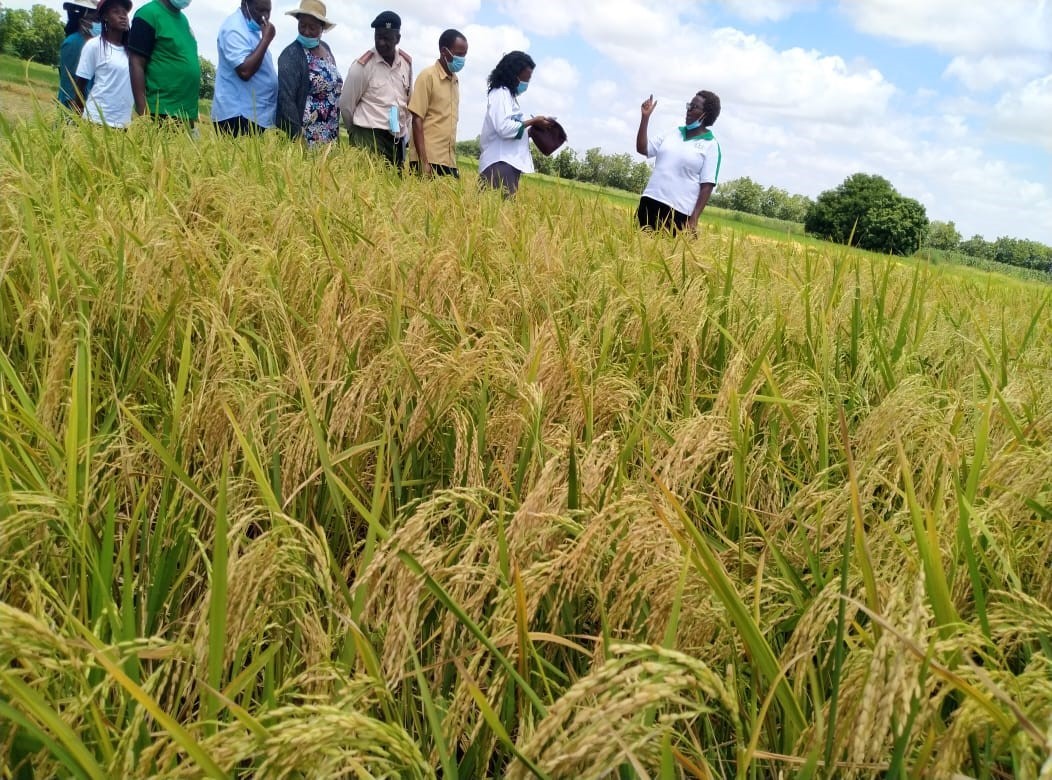Kenya has for the last three days been hosting Rice Breeding Innovations (RBI) National Agricultural Research and Extension Systems Partners’ Annual workshop for East and Southern Africa.
The workshop attended by delegates from the COMESA region, which is the first held in the Country after the COVID 19 pandemic discussed and shared on how countries can be able to strive to achieve rice self-sufficiency in their countries.
Speaking during the workshop, the Kenya Agricultural Livestock and Research Organization (KALRO) Director General Eliud Kireger said Kenya’s rice sufficiency ratio is at 14.7 percent and this state of affairs is a clear indication of need to exchange knowledge among the countries to address the production challenges.
“Currently the rice self-sufficiency ratio for Tanzania and Madagascar is more than 75 percent while for Kenya and Ethiopia is less than 30 percent”, the DG said in a statement read on his behalf by Dr. Lusike Wasilwa, Head of Crop Systems at KALRO.
Dr. Kireger noted the importance of transforming Kenya’s subsistence from smallholder agriculture to commercially oriented sector that sustainably supports the country’s food and nutrition security and socio-economic development.
In view of this, he said that the Government identified rice as one of the three major food security crops along maize and potatoes and currently the annual consumption growth rate for rice is 12 percent compared to maize at 1 percent and wheat 4 percent.
Despite the importance of rice in Kenya, the DG however noted that the domestic sector has not satisfied the increasing demand which continues to escalate by the year.
“The population of the middle class and urbanization of consumers who are increasingly relying on rice for food is growing which means that the demand for food will lead to a significant deficit in milled rice if it is not addressed,” he said
Currently, he explained, the demand for rice per individual per year is 25.3kgs. In 2020 the domestic rice production was estimated at 181,000 MT while consumption was 1.2 million MT forcing the country to import the 953,000 MT of the rice. In the same period, the bulk of rice consumed in Kenya was imported from Asian Countries at sh. 25 billion.
He acknowledged that rice production in Kenya is faced by a myriad of challenges with commercial rice varieties available in the country being low yielding and restricted to lowland irrigated ecologies.
The Meeting Dr. Kireger said, looked at the challenges in rice production and seed systems, exchanged results on promising lines and innovations of all breeding programmes that will be aligned to regional and country products concepts and markets.
Also, top on the discussion list was the Direct Seeded Rice (DSR), A technology for future, to address the emerging scenario of water and labor shortage, informed opportunities for developing and releasing market driven varieties all geared towards improving productivity and competitiveness of domestic rice resulting to self-sufficiency in East and Southern Africa.
Regional Representative of the International Rice Research Institute (IRRI) for Africa, Abdelbagi M. Ismail said that Africa pays more than USD 300 million annually to import rice in East and Southern Africa and in the Sub-Saharan Africa it costs around USD 6.4 billion to import rice from Asia.
“Sub Saharan Africa has resources and enough land of more than 330 million hectares suitable for rice and yet we are only using 12 million hectares and our yields are also low thus the need to cover this gap in production and reduce our imports,” he said
Ismael said that IRRI has come up with various rice seed varieties that can improve the yield of a farmer from 7,000 tonnes to 10,000 tonnes per hectare and ensure they also move from the traditional varieties that have been planted for over 150 years.
He noted the shift in consumer habit and improvement with now most consumers moving to urban counties and no longer want maize or even cassava and root crops because of longer time in preparation.
“Rice is easy to store, quick to prepare and is palatable and we are seeing a social shift to work hard and be able to satisfy the increasing need in rice by first addressing productivity and quality,” Ismail said
He gave an example of Mwea Variety Basmati 370 one of the highest quality rice in Kenya but very old and released in 1958 noting on the need to replace it with the new high end varieties but of the same quality that can produce up to 7 tonnes from the 2 tonnes per hectare that farmers get currently
He challenged Governments to work closely and enforce good policies and release varieties as quickly by engaging the private sector whose role should be geared towards moving from importing around 89 percent of its rice.
Dr. Lusike acknowledged lack of certified planting material that is making production insufficient, high-priced fertilizer but said the country is trying to improve in terms of proper agricultural practices by deploying plant clinics.
“Last week we opened up 12 plant clinics for pest and disease of plants in rice production system that will see over 500 plant doctors provide information on rotational crops in rice products in the areas of Mwea, Bunyala and lunga lunga irrigation schemes,” she noted
Kenya’s rice sub-sector is aligned to Vision 2030, the Medium-Term Plan III, the Government’s Big Four Agenda, the Agricultural Sector Transformation and Growth Strategy, and National Agriculture Investment Plan.
It is supported by technologies, innovations and management practices that are generated and disseminated to stakeholders (KALRO).
The International Rice Research Institute (IRRI) has been partnering with KALRO in technology and infrastructure development, capacity building, knowledge exchange and this has led to the release of the Komboka rice variety – IR05N221.
In addition, two more varieties CSR36 and 08FAN10 are undergoing testing for distinctness, uniformity and stability and will be released in the near future.


